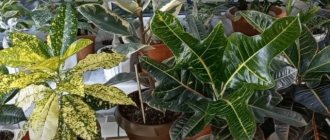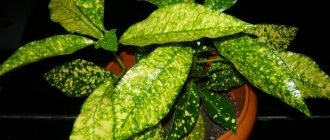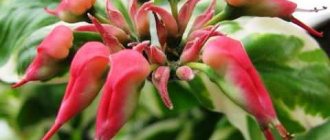Watering
Croton grows well in slightly moist soil without drying it out. Enough moist soil so that the roots are not literally standing in water. It is better to water a small amount of water in several portions regularly than to pour a large amount at once. By touching the ground with your finger, you can easily determine the humidity. If the soil seems dry, water it again. In cooler temperatures and less light (winter), Croton uses less water, so adjust the amount of water accordingly by watering less.
The amount of water depends, among other things, on temperature and light intensity. With a newly purchased plant or after moving, it is advisable to start with a small amount of water. If the soil is still very wet after 4 days, water less. If the soil becomes dry again after 2 days, water again. By regularly checking the soil for moisture by dipping your finger into it, you will automatically know how often and how much water the plant needs.
Water system
If you fill a houseplant with substrate and equip it with a water meter, the water dosage will change. Water once a week. Pay attention; The water drains slowly, so the water meter responds with a delay. In winter, water once every two weeks.
Spraying
Regular spraying of Croton is necessary to prevent the appearance of spider mites. The more often the better, but at least once a week. When the heater is on, it is recommended at least twice a week.
Taking a warm shower twice a year also provides benefits. To do this, cover the soil with cling film so as not to overwater it. The shower has a preventative effect against pests and removes dust from the leaves. This benefits the houseplant and makes it look more beautiful. A dust-free leaf receives more light, which gives the plant a richer color.
☝ Why did I get rid of all my crotons and leave one - narrow-leaved? ✔
I fell in love with crotons at first sight. A tree with luxurious massive leaves, the colors of which are simply unimaginable. It seems that all the colors of autumn have been absorbed by this flower.
My first mole was a beautiful croton of the Excellent variety. Yes, everything was perfect in it, from the shape of the leaves to their color. The second variety I got was Gold dust. The third baby in my collection was Wilma. And the last thing I bought was a small cutting, I don’t know its name, people call it narrow-leaved .
What can I say about all these crotons I had? The fame of this whimsical plant is greatly exaggerated. It is necessary to ensure that the soil is always slightly moist and that the plant is not in a cold room. In winter from 18 degrees and above. That's the whole secret. And also - copious spraying. Otherwise, besides you, spider mites will also love crotons.
For rapid growth, I took all my little ones to the balcony in the summer. And then in the winter I treated them for spider mites. And so on from year to year.
One winter day I was so tired of this abundance of mites on the crotons that I simply got rid of them all. I left only one, for which a one-time treatment after the summer is enough and no one eats it all winter. Perhaps, due to its narrow, not massive leaves, it is not as interesting to the mite as its counterparts with large leaves.
Honestly, if I had only crotons, I would continue this fight against spider mites, but I have a large collection of plants and simply do not have time to get rid of colonies of these insects every week, which multiply at the speed of sound in a dry, hot room in winter.
And here is my narrow-leaved beauty, which I grew from a small cutting and which is not at all interesting to spider mites and does not give me any problems in caring for.
Luxurious crotons to all, so that they delight you with their beauty!
Croton belongs to the genus Euphorbiaceae, which contains about 1,300 species, widely distributed in the tropical regions of the New and Old Worlds. The plant is best represented in the Americas, with about 65 species found in continental Africa and about 125 in Madagascar. This plant grows in an assortment of shapes and colors, including red, orange, purple, pink, yellow, green and white.
Outdoors, crotons grow as fun container plants, accenting other favorites such as lantana, angelonia and pentas. In warm, frost-free climates, crotons grow as living landscape shrubs. They are often used as dramatic hedges or colorful accents in the yard. Of the long list of widows, only variegated croton is suitable for indoor growing. Several hybrid varieties have been bred on its basis; their photos can be found in the catalogs of many stores.
Light and warmth
The miracle bush prefers to receive a lot of light. But be careful of direct sunlight during the summer months. Croton is grown in diffused light, avoiding drafts. If it is in front of a south-facing window, it is recommended to maintain a distance of 2 to 3 meters. Gradually the plant can be brought closer to the window.
Croton needs at least 5 hours of good light per day. Therefore, it is advisable to place these indoor plants directly in front of a window in the east, west or north. If there is insufficient light, fresh leaves will not appear and the plant may droop existing leaves. If predominantly dark leaves are present, the indoor plant can be placed a meter closer to the window.
Minimum temperature
| During the day: | 18 ℃ |
| 'At night, in the evening: | 12 ℃ |
Croton species
Croton laxative (Croton tiglium)
A small shrub or tree up to 12 m tall, evergreen. Leaves are alternate, membranous, ovate with a broadly rounded, sometimes slightly drooping base, pointed, acute or obtuse, very finely serrated, glabrous above, with several star-shaped hairs below, 7.5-17 cm long, 4-9.5 cm wide, from metallic green to bronze or orange. The petiole is thin, about 4 cm long; conditionally yellow, 1.5-3.5 mm long. The inflorescence axis is bare; the flowers are small and inconspicuous. Male flowers are star-shaped and hairy with narrowly elongated petals and 15-20 stamens; female flowers are apetalous; capsule with stellate hairs, triangular, 15-20 mm long, 10-15 mm wide, oblong or ellipsoid, 3-lobed. Seeds 3 per fruit, oblong-ovate, orange, about 12 mm long, smooth
Croton lechleri
It is a flowering plant with a broad but open crown, native to northwestern South America. It grows up to 20 meters in height with a trunk diameter of usually 30 cm. It is also known as Sangre de Drago. It is characterized by thick red latex, which has medicinal properties. It is used as a liquid dressing for wounds and other skin injuries and disorders. It is an effective antiviral treatment and is also used in the treatment of tumors.
Variegated Croton (Croton variegatum)
With its gorgeous foliage in rich fall colors, garden croton exudes living space comfort and good cheer. Fine varieties of this species with impressively decorative leaves also serve as a refreshing air freshener. It's no surprise that the tropical, evergreen ornamental plant is at the top of the list of most popular houseplants. The most
Transfer
Replant Croton in the spring or immediately after purchase. Repeat this when the pot becomes too small. This is possible after a year, but usually once every 2 years is sufficient. Replanting is preferable in the spring, since at this time damaged roots are restored faster. Place the houseplant in a pot that is at least 20% wider than the pot it is in, and use regular potting soil. Do not place hydropellets in the bottom if the pot is closed. Stagnant water that accumulates between the grains of the hydraulic system cannot be easily reached by the roots and rotting occurs.
A larger pot encourages growth, improves plant health, and creates a buffer for more water because the soil can absorb more moisture. The latter ultimately simplifies the maintenance of Croton.
Lobed varieties of crotons
In appearance, the plants are similar to three-lobed varieties of codiaum. The main difference is that the leaf plate is solid, without side blades. It can be of different sizes and colors. There are indoor flowers with pointed and rounded tips. Let's look at the most popular varieties.
Croton Petra
One of the most favorite varieties among gardeners. Thanks to its densely leafy straight trunk, it creates the impression of a luxurious, slender tree. Main features of the plant:
bush height is about 0.7 m;
the leaf blade is large, compacted, lobed, oval or pointed in shape;
The color is dark green with contrasting yellow veins.
Codiaum needs good lighting and spraying. Does not like dry air and drafts. Therefore, it is not recommended to place it near heating devices or in ventilated areas.
Croton Mrs. Eyeston
A very beautiful variety, valued for the color and appearance of the leaves. The shape is a slender tree, the trunk of which is not visible due to the abundance of foliage. Main characteristics of the codiaum:
plant height is more than 1 m;
leathery leaves are small, oval, with pointed tips;
The colors are varied, depending on the age of the leaves and growing conditions.
Young leaves are green with cream spots. As they grow older, yellow, pink, maroon and even black stains appear on the plates. The indoor plant remains decorative provided that the earthen ball and leaves are constantly moistened.
Croton Gold Sun
A spectacular variety that looks appropriate both in the office and at home. The shape is a densely leafy tree. The main features of a houseplant:
codiaum height is about 30 cm;
the leathery leaf blade is ellipsoidal, narrow at the base and at the tip, widened in the middle;
The color is rich green with yellow splashes.
Gold Sun loves diffused light and humid air. It is recommended to replant a young, fast-growing plant annually in spring or autumn, gradually enlarging the pot. For adult specimens, replanting once every 3-4 years is sufficient.
Read also: Rose Super Dorothy encyclopedia of roses
croton mix in flower shops . This name hides about 20 varieties with different leaf shapes and sizes . They usually grow as a densely leafy tree. Crotons, although whimsical, are very beautiful flowers. By following the basic rules of agricultural technology, you can grow any of the varieties described above on a windowsill.
Trimming
If Croton grows too tall, you can prune it by cutting down the trunk. It is better to do this in spring or summer so that the trunk sprouts again. It is advisable to prune the shoots before each fall so that in winter more light reaches the core of the indoor plant. In spring Croton sprouts again. When trimmed, it will emit a milky white color that can be stopped with coal chips or cigarette ash. Once cut, the trunk will be susceptible to bacterial infections. We recommend sealing the cut with wax or cigarette ash.
Reproduction of Codiaum:
Propagated by cuttings, air layering and seeds.
Cuttings for propagation of Codiaum are mainly obtained by pruning the plant. At first, the cutting must be kept in water so that the milky juice drains and does not dry out, after which the cutting is washed in clean water. Root in soil at a temperature of 22-25°C in a room with bright lighting, under a greenhouse, where constant humidity is maintained. Rooting stimulants can be used. On average, rooting takes place within 30 days.
A new plant can be obtained using air layering. The branch must be buried in the ground and secured with wire or a pin. If the layer is semi-lignified, it is necessary to remove the bark and treat the area with root. Roots appear on average within a month.
Codiaeum petra.
Seeds are planted mainly in the second half of winter. Before planting, seeds must be soaked in a germination stimulator for 24 hours. Sow, deepen with light pressure, cover with glass, cling film or bag, you can use bottom heating. The greenhouse is ventilated daily and the soil is sprayed. Shoots can be expected 3-4 weeks after sowing. When the seedlings reach a size of 3-5 cm, you can pick them in different pots.
Types
Various species of Croton are known. Some varieties: Petra, Mammy, Sunny Star, Tamara, Curly Boy, Excellent and Red Banana.
Croton Petra
The most famous Croton is Petra, this species has the most brightly colored leaves. The great thing about this type of Croton is that the leaf vein is the same color as the leaf, just a brighter color. This gives a pleasant effect.
Croton Norma
Croton Norma has pointed leaves with a glossy surface with a slight depression in the middle. This is an exclusive variety.
Croton Miss Eyeston
The most accessible Croton is Miss Iceton. Unlike Peter, it has no noticeable veins on the leaves, it has a beautiful smooth soft leaf.
Croton Gold Dust
Dark green Croton, with golden yellow speckles. It comes in a variety of colors: yellow, red, copper, green, pink, ivory, orange and brown.
The brighter place you place this Croton, the more spots there will be on its leaves.
Croton Curly Boy
Croton Curly Boy gets its name from its curly leaves and deep red color. This Croton remains relatively dark even if you place it in a lighter location.
Croton Mammy
Croton Mummy - Similar to Curly Boy, but with slightly less curved leaves and more variety in color. The great thing about this Crotona is that it can come in very rich colors.
Croton Codeium Excellent
A dark variety with inconspicuous leaf veins. Croton Kodiema Excellenta has unique leaves, they say if you are very creative, you can see a parrot's head in them.
Diseases and pests of croton
Croton rarely gets sick because it is poisonous, but insufficient care can lead to various diseases. It is advisable to familiarize yourself with some of his diseases.
- Anthracnose is a fungal disease. It occurs when overwatering with cold water. A sign of anthracnose is the appearance of reddish or grayish-ashy spots on the leaves. The fungus penetrates the leaf veins and destroys the plant. The pot with the diseased plant is urgently isolated from the rest and treated with an antifungal drug. It is better to spray all plants in contact with it with biological products to avoid infection.
- Root rot - appears when the soil acidity is low. The leaves turn pale, dry out and fall off. In a diseased plant, the roots become soft, flaking, and they rot. To combat root rot, broad-spectrum antifungal drugs are used.
- It happens that the tips of croton leaves begin to dry - this is due to lack of moisture in the soil and in the air. It is necessary to water the flower more abundantly and spray its leaves. To increase the humidity in the room, you can place containers of water next to the pot.
- If brown spots appear on the leaves of the plant, this is due to direct sunlight hitting the flower, especially in the summer. Adjust the watering mode and remove the pot from the sunny windowsill - the croton will come to life again. And dry ends can be carefully trimmed.
- The appearance of a brown edge on the leaves indicates that the plant is cold; it is necessary to increase the temperature of the air surrounding the croton.
- If the leaves begin to turn pale and cease to be bright and colorful, the plant does not have enough lighting, move it to a brighter place.
- If the leaves fall, the plant is most likely cold, uncomfortable, and lacks nutrition and moisture.
This may be interesting: Indoor Soleirolia (Gelxina): care and other nuances of growing
Anthracnose Root rot Scale insect Mealybug
- On diseased plants, spider mites may appear - a thin web on the stems and leaves of the flower. It appears due to a combination of two reasons - dry air and insufficient watering.
- If a light fluffy coating appears on the leaves, it is a mealybug.
- Sometimes croton is affected by scale insects - light areas appear on the leaves in places where the pest feeds.
In all these cases, pots with diseased plants should be taken to the bathroom and there all the leaves on both sides should be treated with a soap solution. Then wipe them with regular vegetable oil. If a flower is severely damaged by pests, it is treated with special preparations - insecticides, such as karbofos or actellik. In fact, the appearance of pests and diseases of croton is caused by two factors - insufficient ambient humidity and improper watering of the plant. If you provide these conditions to your flowers, they will never get sick and pests will not disturb them.
Description of the plant
Croton (codium) is an evergreen perennial plant of the Euphorbiaceae family. There are 14 known species. Numerous varieties and forms of variegated codiaeum (Croton) (Codiaeum variegatum var. pictum) are common in indoor floriculture.
The shiny leathery leaves have different shapes (more than two dozen options), bizarre shapes and colors. On the leaves you can see pink and bronze spots, lemon, yellow and orange stripes, red, pink and yellow veins, black eyeliner, etc. Some gardeners call this leaf coloring painting.
Very beautiful shape and color of the leaves of this codiaum (croton)
Croton, an ornamental deciduous shrub or low branched tree with brightly colored leaves, is popular in many countries. In warm regions it is grown outdoors, but for us Croton (Codium) variegated remains only a houseplant. Large specimens are kept in greenhouses, winter gardens and offices. Designers use branches and brightly colored leaves to create bouquets and various compositions.
Breeders have managed to develop fantastically beautiful compact varieties that are suitable for small spaces. Unfortunately, all crotons are demanding in care and do not forgive mistakes that other indoor plants do not notice.











